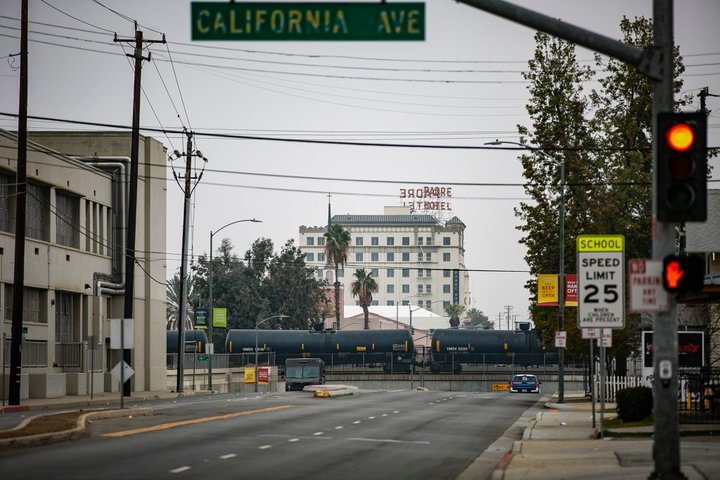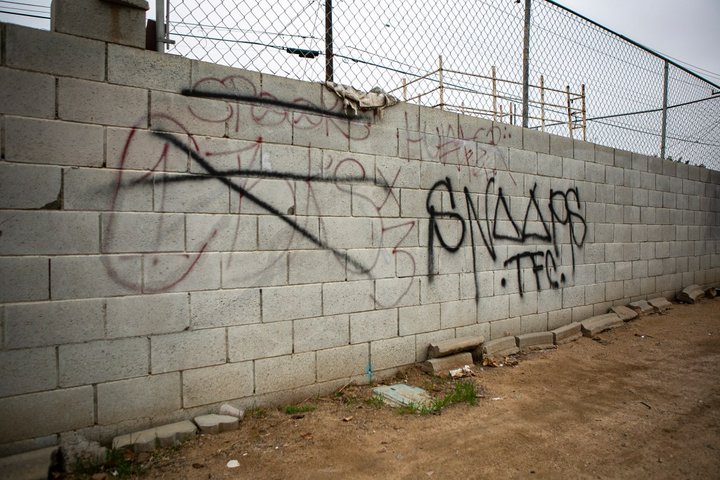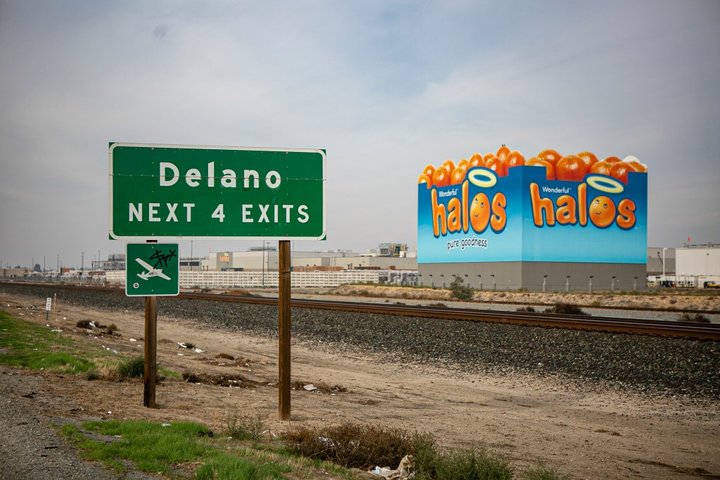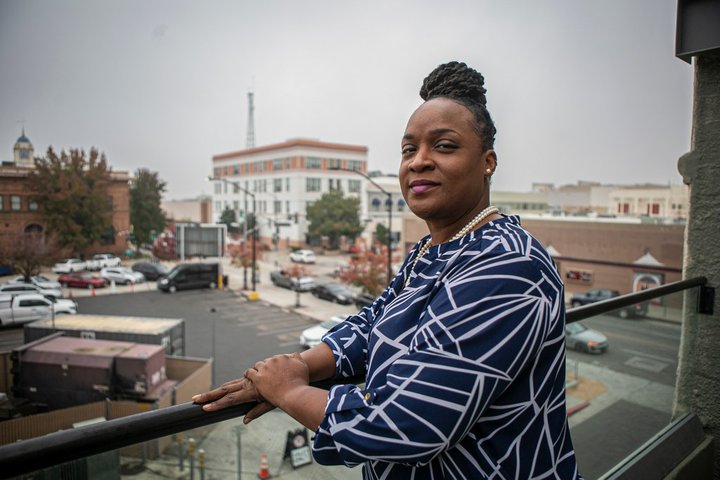
A memorial is set up on the corner of Foothill Road and Morning Drive for 17-year-old Jose Flores in east Bakersfield on Nov. 16, 2021. Flores was stabbed and killed in a fight near Foothill High School in January of last year. Photo by Larry Valenzuela for Calmatters.
With its back to the desert, Kern County is the southernmost band of California’s conservative Central Valley. Its western border forms a jagged staircase that mimics the shape of California’s coastline without ever approaching the water.
And along its rural northern border is a long-running war between rival prison gangs that helped make this county so violent.
The homicide rate in Kern County in 2020 was 12.7 per 100,000 residents, the highest of any California county, according to the Department of Justice. That’s about one for every 8,000 people in a county of about 900,000.
Beginning in the middle of the last decade, the county’s homicide rate began to grow, and Kern County has had the highest homicide rate in the state since 2016.
Crime is up across the country and especially in California. What this means, and who’s at fault, remains a useful political cudgel.
The state’s rising homicide rate – up 31% from 2019 to 2020 — was a central aspect of the unsuccessful recall of Gov. Gavin Newsom. Republican Larry Elder, the leading vote-getter among Newsom’s challengers, decried the “soft-on-crime ethos that we see emanating from Sacramento and from many of our major cities.” Kevin Falconer, another Newsom challenger, said the rising crime rate forced major employers to pull out of San Francisco.
Nationally, stories about rising crime focus on the big cities: Minneapolis after protests surrounding the murder of George Floyd. Portland since weekly clashes began between anti-fascists and right-wing paramilitary groups. And Chicago — always Chicago.
But one of the most violent places in California defies those explanations. There is no active movement in Kern County to change how police departments are armed or funded, no lenient district attorney pushing for lower sentences, and few black-clad agitators to be found.
Bakersfield, the largest city with about 380,000 residents, set a record in 2020 with 45 homicides. This year, it blew past that: By late November, 57 homicides had been recorded.

The Padre Hotel in downtown Bakersfield on Nov. 16, 2021. Photo by Larry Valenzuela for CalMatters
Residents woke up nearly every morning in the first 15 days of August to a new homicide.
Ask around Kern County about these grim figures and you’ll hear a variety of explanations: violent video games, the erosion of the nuclear family, the end of corporal punishment.
Some blame a state law that changed felonies to misdemeanors, a law that lowered prison sentences, a failed penny tax for more county deputies and a successful penny tax for more city cops.
The explanations are local, national, global: The closure of the local soccer field every day but Saturday, the wide availability of firearms, gang warfare, Donald Trump, Barack Obama, Gavin Newsom, Ronald Reagan, joblessness, hopelessness and the approaching fourth calendar year of a global pandemic.
So what makes Kern County’s homicide rate the highest in California? How did Bakersfield get named one of the top 10 most dangerous cities in the U.S.?
“Honestly,” said Manuel Carrizales, a pastor and former Bakersfield gang member, throwing his hands in the air and letting them fall to his lap in resignation, “a devil is on the loose.”
Leaders dodge unpopular topic
A long-range look at crime statistics, particularly homicide data, shows that the 2020 crime rate nationally and in California was still a fraction of its highs in the early 1990s, according to government statistics. Simply counting the year-over-year changes belies a larger truth: Crime is down significantly compared to recent history.
Even so, the year-over-year changes to the crime rate are notable, especially when it comes to the homicide rate, said Magnus Lofstrom, policy director of criminal justice at the Public Policy Institute of California.
“But I think it’s also important to take a step back and look from that longer-term perspective and recognize that, over decades, our crime rates — even in 2020 — were relatively low,” he said.
In 2015, amid the earliest signs of a rising homicide rate in Kern County, Bakersfield television station KGET started a homicide tracker.

The Padre Hotel in downtown Bakersfield on Nov. 16, 2021. Photo by Larry Valenzuela for CalMatters
Reporter Raphael Stroud joined the station in 2017, and it was his job to drive out to every homicide and tell the story of the deceased.
He kept looking to officials and elected leaders for explanations, he said. The ones he got were mostly complaints about the behavior and attitudes of school-age kids, he said.
“I stopped wanting to do interviews with officials because I kept hearing the same thing,” Stroud said.
The homicide rate apparently is not an issue local elected officials are eager to discuss.
CalMatters made multiple attempts to reach the Bakersfield mayor and all five Kern County supervisors. None returned calls. Kern County Board of Supervisors Chairman Phillip Peters’ chief of staff said he would not comment, and Bakersfield Mayor Karen Goh’s staff said in November she was traveling and too busy for a 15-minute interview on two consecutive record-breaking years of violence in her city.
In her 17-minute, 51-second State of the City address in July, Goh pledged a “new optimism” for solving homelessness in the city, praised a new regional branding initiative and mourned the lives and businesses lost to the pandemic.
“God bless you, Bakersfield,” she said. “We’re coming back better than before.”
She did not make a single mention of the number of people killed in 2020.
Gangs infiltrate rural towns
A decade ago, Kern County wasn’t notable for its homicide rate. In 2011, according to the Department of Justice, its homicide rate was 5.4 per 100,000, about the middle of the pack in California.
What happened?
Within the city, local crime data show, fighting among longtime local gangs divided by race and geography made up at least one-third of the city’s homicides in 2020.
The Bakersfield Police Department categorized 15 of its 45 homicides as gang-related that year. But that, acknowledges Bakersfield police spokesman Robert Pair, is only the number of homicides that police could prove were related to organized crime.
“The true number is likely much higher, but we don’t code it ‘gang-related’ just based upon suspicion, or the person’s history alone,” Pair said.
In several instances, Pair said, the homicide victims may not have had gang affiliations, but were killed based on suspicion alone.
“It’s a gang border. Gang activity has its peaks and valleys, kind of a roller coaster.”
— Tyson Davis, Delano Police Chief
A farming county that grows and exports almonds, grapes and citrus, Kern County has California’s fifth highest poverty rate — nearly one in five lives below the poverty line, federal data show. The county’s median household income is about $20,000 less than the statewide median, according to the U.S. Census.
The county is made up of small commodity-dependent towns, and gang violence has spread from the city to those rural outposts.
Two are at the center of a war between two of California’s largest prison gangs, according to Kern County law enforcement.
Delano, population 53,000, is centered around the Wonderful Company mandarin oranges packaging plant. The town of McFarland, seven miles to the south with 15,000 residents, is famous for its high school cross country team, which was the subject of a 2015 movie starring Kevin Costner.
Delano Police Chief Tyson Davis said his town is the southernmost one run by the norteño prison gang, who wear red. McFarland is the northernmost town run by the sureño prison gang, who wear blue.

The Wonderful Halos orange packing facility outside of Delano on Nov. 15, 2021. Photo by Larry Valenzuela for CalMatters
“It’s kind of a cut-off area,” said Davis, who took office in late October. “It’s a gang border. Gang activity has its peaks and valleys, kind of a roller coaster.
“This didn’t happen overnight. This has been a growing problem for years, and it’s going to take years to get out of it.”
Davis did not have statistics on gang activity in Delano, but some recent incidents and court cases tell the story.
On July 2, 2020, a tan Toyota sedan reportedly pulled up to a birthday party in Delano. Witnesses told police a man in a hoodie stepped out of the car and started shooting. Three adults were injured. Two girls, ages 11 and 12, were killed.
Delano police told television station ABC23 at the time that witnesses at the scene did not cooperate with police and were in some cases “flat-out hostile.” The Delano police coded the shooting as gang-related, but no arrests have been made.
Gang violence also claimed the life of the 21-year-old son of a pastor, killed at a vigil in Delano for a car-crash victim in February 2020.
Are statewide policies to blame?
Davis, a former Kern County sheriff’s deputy for 31 years, blames a pair of laws for the region’s violence: 2014’s Prop 47, which reclassified some drug and theft felonies to misdemeanors, and 2016’s Prop 57, which leaves to a judge’s discretion whether juvenile offenders are prosecuted in adult court.
Davis and other law enforcement officers in Kern County also blame the 2011 prison realignment created by AB 109, which made incarcerated people previously in state prisons eligible for sentences in county jails instead.
That, said Davis, caused a backup in the county jails, which then released more people onto the street.
“Those are people who like to commit crimes,” Davis said.
Researchers who looked at the impact of those measures did not find them associated with more assaults or homicides.
If Prop 47 contributed to any crimes, it was larceny, according to a Public Policy Institute of California analysis. Prop 57 has evened some of the racial disparities in juvenile sentences, but, according to the Center on Juvenile and Criminal Justice, Black and brown kids are still being sent to adult court far more than their white counterparts.
Realignment, according to multiple analyses, didn’t end up costing less – jails ended up taking on the costs passed down by prisons – but neither has it been shown to correlate with a rise in homicides.
“We do not find any evidence that violent crime went up as a result of the reforms,” Loftstrom said.
More money for police lauded, rejected
Is it money? Police departments regularly use a rising crime rate to advocate for more public safety dollars – as recently as late November, the Los Angeles Police Department asked for an additional $213 million to hire and retain officers, citing rising crime.
After the groundswell of protests against police violence following the death of George Floyd, the LAPD received $150 million less in 2020 than its original budget forecast. This year, the city added dollars back and the department’s budget is now more than $1.75 billion.
In Kern County, few people appear to be talking about defunding the police.
“I’m a liberal Democrat and I don’t believe that defund bullshit,” said Bakersfield defense attorney David Torres. “No one’s trying to take the sheriff’s money or his deputies’ guns away.”
The question, Torres said, is how those dollars are spent.
“Deputies are never going to stop bitching,” Torres said. “They are very well funded in this county.”
The problem in Kern County is law enforcement departments attempting to retain officers, said Davis and the county sheriff, especially when other local departments can pay better.
Kern County Sheriff Donny Youngblood said he’s been hamstrung by the failure in 2018 of a one-cent county sales tax that he said would have saved county sheriff’s jobs.
“We have been having a very difficult time recruiting and retaining deputy sheriffs.”
— Donny Youngblood, Kern County sheriff
Three years ago, Youngblood shut down the sheriff department’s gang unit. In early November, he also cut the narcotics unit in half.
But in town, money hasn’t been the problem for the Bakersfield Police Department. In 2018, the city of Bakersfield successfully lobbied for a voter-approved one-cent sales tax that brings in about $58 million each year for public safety.
That, said Youngblood, has posed a problem for his office.
“It’s been horrendous,” Youngblood said. “We have been having a very difficult time recruiting and retaining the deputy sheriffs. Several have gone to the city because the city is offering a substantial pay raise, you know, it’s just very problematic.”
Long before that tax, Youngblood was calling for more funding.
“We offer a $25,000 signing bonus for lateral transfers and in two years we’ve had zero successful takers,” Youngblood said. “We’ve had applicants apply, but they failed a background [check] from other agencies, or if they don’t pass the background [check], they refuse to sign a waiver for us to look at their background. We don’t hire them.”
When asked for a single driving cause for the rise in homicides in Kern County, Youngblood had a hard time identifying one.
“Did you say per-capita we’re the No. 1 in homicides?” Youngblood asked in an interview. “I didn’t realize it.”
‘It gets pretty wild here’
A restaurant owner, a bail bondsman and a private eye sit in the front seat of a black Dodge Challenger, rumbling through the streets of Bakersfield.
It sounds like the setup to a joke, but Glenn Pierce is all three. And he says he is willing to shell out more tax money for more police officers, though his opinions of the local cops are mostly unprintable.
Pierce owns Pierce Bail Bonds, operates a 30-seat soul food restaurant and works as a private investigator for criminal defense attorneys. He said his older brother is still a high-ranking Bakersfield Crip.
“The bad guys talk to me and the good guys talk to me,” said Pierce who, at 6-feet-4, is imposing even while driving.
“We need more substations… Not only more officers, but ones who know who you are, who the kids are.”
— Natesha Johnson, Bakersfield community organizer
Ask around Bakersfield who has insight on violent crime here, and many – from cops to defense attorneys to journalists – will point you to Glenn Pierce.
Just like everyone else, though, he’s stumped.
On one fall afternoon, he pulled up to a six-foot white wall on a residential street, where graffiti reading “Peace Ghost” marks one of the first gang homicides in Bakersfield this year, Oscar Ortiz “Ghost” Cervantes.
“And that (homicide) probably led to another one,” Pierce said.
Community organizers argue that the police need to do more block-by-block policing, showing their faces and letting their presence be known.
“We need more sub-stations, more officers walking the beat,” said Natesha Johnson, a Bakersfield community organizer whose son joined the police department this year. “Not only more officers, but ones who know who you are, who the kids are.”
Pierce disagrees.
“No. No way,” he said. “That officer will end up stuffed in the back of a trunk. It gets pretty wild here at night.”

Natesha Johnson, CEO of Upside Productions and community organizer, at The Padre Hotel in downtown Bakersfield on Nov. 15, 2021. Kern County and Bakersfield have an elevated amount of gun violence and deaths. Photo by Larry Valenzuela for CalMatters
As he rumbles through town, Pierce points out the graffiti marking gang territory. “X3,” that’s a gang aligned with the sureños. The “OKC” on the side of an abandoned lumber supply store stands for the Okie Bakers, a Latino gang that Pierce said stopped paying its taxes to the larger sureño criminal network, and it’s getting their people shot.
But he also sees structural problems in Kern County.
“There’s no jobs here. There’s no training,” Pierce said. “The closest training area for the oil fields is 25 miles away and there’s no cars.”
That, he said, leads to trouble.
“They send them to prison, they send them to jail. There’s nowhere to send them to.” Pierce said. “They want to blame everything on the governor, but you can’t blame everything on one guy.”
He points to the success story of Monterey County, which saw a spike in gang violence at the end of the 2000s and again in the middle of the 2010s.
But, according to local media reports, a ceasefire between the gangs led by police agencies and nonprofits helped Monterey County reduce its homicide rate between 2015 – when it was higher than Kern County has ever reached – and 2020, when the rate was 3.2 per 100,000.
“The Monterey County gang unit started hammering the hell out of them,” Pierce said.
Chasing theories on county’s violence
For Raphael Stroud, the former Bakersfield TV reporter who covered every homicide in the city between 2018 and 2020, looking for a pattern ended fruitlessly.
“They’ll blame Sacramento, or they’ll say it’s got to be the community that comes together and won’t stand for this,” Stroud said.
He doesn’t mean to come off as dismissive, he said. But none of the explanations he said he heard from community activists, city officials, police officers or even the gang members themselves were satisfactory.
He chased theories: Maybe environmental pollutants were causing lower test scores in schoolchildren, leading to more crime. Maybe the density of state prisons led to more people staying around after their release – until he realized prisoners, upon release, are returned to the county where they were convicted.
Maybe the cheap real estate in Bakersfield – one of the last pieces of affordable housing left on I-5 – was drawing people in from Los Angeles and Oakland who were committing crime, until he realized many of the homicides he was covering came from families with decades-long roots in Kern County: “It’s home-grown.”
“When I wasn’t going to get straight answers from the city and the police, I tried to switch up to focusing on the pain it’s causing,” said Stroud, now a TV reporter in the Bay Area. “One thing that broke my heart, I think there’s a lot of apathy (in the community).
“They think there’s certain parts of Kern County where it’s the family’s fault, it’s the neighborhood’s fault. That’s what probably bothers me the most.”
On Nov. 17, police found a man shot to death in a Bakersfield home on Panama Lane just after 6 p.m. They have not released his name or any information on suspects. It was the city’s 57th homicide this year.
###
CALmatters.org is a nonprofit, nonpartisan media venture explaining California policies and politics.
CLICK TO MANAGE